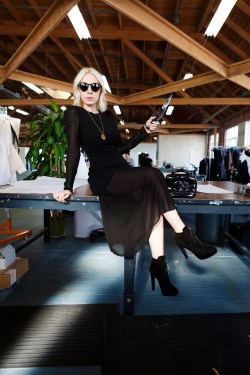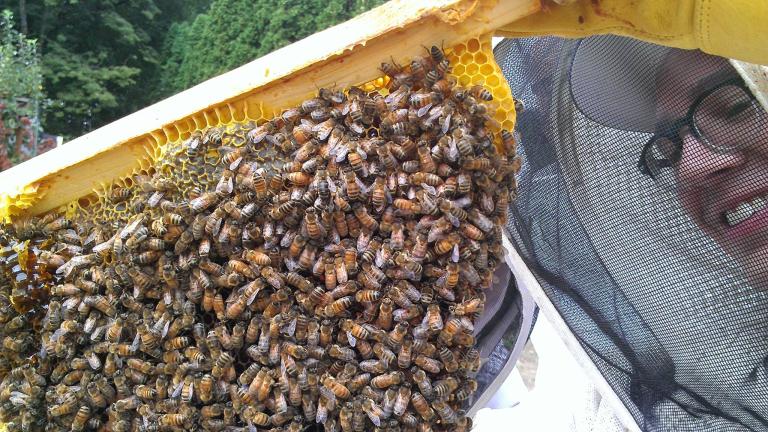It’s no surprise that the fashion industry is trashing the planet like it’s going out of style. Garments and textiles are one of the most chemically dependent industries on earth and the No. 2 polluter of clean water. Petroleum-based synthetics like polyester take forever to decompose. And in 2012, about 14.3 million tons of textiles were sent to the landfill.
Even though the idea of sustainable clothing has recently been seeping into the mainstream, design and price points are still a huge factor. So what can a green-minded fashionista do to get her paws on some chic eco-fashion styles without busting her bank account or looking like she just stepped out of Hemp Hippie magazine?
Enter The Reformation, a sustainable clothing company with a high couture twist. A small army of “Ref babes” hunts down materials from vintage and “deadstock” (outdated and unsold merchandise bought directly from designers). The discarded items then get repurposed and up-cycled into fresh, modern, and original designs. And with a store in New York and Los Angeles, they’re growing — they created America’s first sustainable sewing factory in Los Angeles in 2013, and they’ve just hired a sustainability manager to oversee even more of their green efforts.
The founder of The Reformation, Yael Aflalo, earned her fashion industry chops working for eclectic designer Fred Segal in Los Angeles. She started her own clothing company, Ya-Ya, in 1999, at the tender age of 21, with only a year of fashion design school under her belt. She sat down to talk about her design inspirations, if big box stores can really go green, and the secret to making sustainable clothing cool and desirable. Here’s an edited and condensed version of what she had to say.
Q. How do you source your materials?
A. We get our material from three ways. One is from vintage. We’ll basically just buy vintage clothing in bulk from domestic resources. The second is from overstock: We go directly to designers and buy their extra material. And the third thing that we’re doing is developing a line of sustainable fabrics.
Q. What kinds of creative challenges do you face by reusing fabrics?
A. I was a traditional designer for over 10 years. What happens is that you sit there in the beginning of the season and you’re like, “What do I do?” There are no boundaries, no limitations. It’s like designing in what feels like a vacuum. It’s really nice to have starting points, to say OK, this is what I have to work with and let’s start here. I prefer it. Limitations make it less taxing to make choices.
Q. What’s the fashion industry’s dirtiest habit?
A. I just think it’s the blatant disregard for the environmental impact of the product. It sucks, because usually sustainability people inside companies are just not very operational. I mean, there are analytical reports that are submitted, but I’m not sure how much they’re being listened to. There are simple things to change that people just don’t do. There’s a lot of room to improve.
Q. You started your first clothing company, Ya-Ya, in 1999. How and when did you realize that the industry is so wasteful?
A. It was sort of a series of events. I get really annoyed with clutter; that was the first thing that happened. For example, if you want to order a look book, you have to do a printed look book. And when you have to order them you only need like a 100 of them, but the minimum is like 1,000. And then the warehouse and the offices are just filled with letterhead and business cards and line sheets. I would just get so annoyed with it. The same thing applies to samples, where you had to make multiple duplicate sets. I was like, what is this all for? It felt very … claustrophobic.
And then I just started to become more educated on the subject. I was like, wow, some of these dresses are made out of petroleum. I went to China to work on a project that was like 80 percent manufacturing fashion products, and I just couldn’t believe the waste and the pollution I was seeing firsthand.
Q. What was the initial response to The Reformation?

Reformation
A. When we first went out and we told our fashion PR company that we wanted to be a sustainable clothing company, they said nobody wants to hear it. I was like, “Fuck this! We’re going to create a new way of marketing.” And so far I think we’ve done a great job repositioning sustainable and green clothing.
Q. You created America’s first sustainable sewing factory last year! Tell us about that.
A. It’s not solar yet — we’re working on that — but it has all energy-efficient fixtures. It gets all of its energy from renewable resources, so it’s off the grid. We do different things across the board, from not using plastic to using recycled material to using recycled packaging products or not use packaging at all, not using harmful soaps and dyes, all that kind of stuff. And we’re adding new projects. Right now we’re working on a greywater system and an indigenous garden in the backyard.
We release products in two to six weeks, we manufacture 80 percent of our products in our own facility where we can monitor all the practices and behaviors. It’s harder for big companies to be agile and change like that. The bigger you get the harder it is to change.
Q. Do you buy H&M’s recent sustainability push? Is it even possible for big-box stores that push cheap clothing to be green?
A. I feel positive about the way that consumer behavior is changing. I think that more and more consumers are requiring a holistic kind of approach to what they buy. And I don’t see those tides changing. I think it will be slower than a lot of people would like, but in 10 years I don’t think people are going to be happy buying things without knowing where they come from. I think it’s a little more difficult for somebody like H&M, where they’re so margin-concerned. They have to kind of kowtow to the bottom line. But improvement and awareness in any way is important and the right step.
Q. What’s your secret to making fashion sustainable and green yet also hip and cool?
A. We always go product first. I think a lot of the problems that sustainable brands have had is that they always go sustainability first and maybe the product is not as important. I don’t think people buy things because they’re sustainable. People buy things because they’re a great product, because there’s a high value proposition. The mission or sustainability is just sort of tertiary.
With fashion and sustainability, we are in our infancy stage of consumer awareness. A lot of times the fashion consumer is even a little more behind than other consumers. So for us it’s about building awareness, developing education around it, and then giving our consumers helpful tools to improve their lifestyles in digestible ways.
Q. What are your design inspirations at the moment?
A. Right now we’re focusing on different body types. We’re thinking about adding on new body types and having different fit models, and doing it that way as opposed to doing these kind of big-box retail, very bland, boxy fits that just try to capture everybody inside of it. I know it’s not unicorns running through a rainforest or anything, but I tend to be more of a pragmatist.



